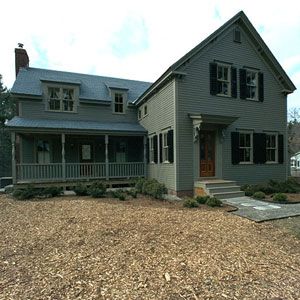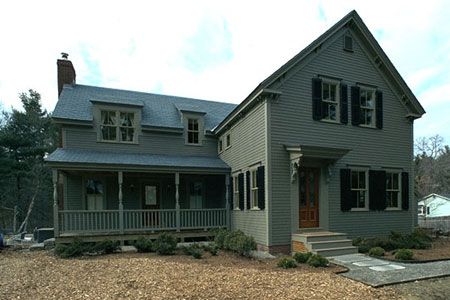
Once Dick and Sandy’s landscape master plan was complete, it was time to plant. As with any yard, this site has particular soil, sun, shade and climatic conditions that I took into consideration when I selected and arranged the plants. Billerica is in a Zone 6 hardiness climate. Plant
hardiness zones are also known as climate zones or growing zones. (Zone 6 landscapes have low temperatures of approximately -10 to 0 F.) Knowing your hardiness zone can help you figure out which plants will grow best where you live.
In Billerica, the loose, informal landscaping complements the character of the house and will eventually blend with the wooded areas at the edge of the property. In the front of the yard, a large existing Japanese maple (Acer palmatum ‘Atropurpureum’) serves as a beautiful focal point. At the perimeter of the property, mature oak trees define the yard and screen the neighboring houses. An additional red maple (Acer rubrum) and a Katsura tree (Cercidiphyllum japonicum) complement the existing trees in form and texture. A small grove of crabapple trees planted adjacent to the front porch will recall the traditional apple groves of rural towns in the area. At the north property line, a grouping of silver bells (Halesia carolina) provides a backdrop for an herb garden.
In addition to trees, I called for layers of shrubs to add depth and variety to the landscape. Clusters of different plants can contrast nicely at close range, while large swaths of single species plantings appear as striking blocks from farther away. For example, at close range, the white-margined, leathery leaves of daphne (Daphne odora) accent the fine texture and flower of spirea Blue Mist (Caryopteris x clandonensis), while the bold round heads of hydrangeas contrast with the upright
spires of summersweet (Clethra alnifolia). A collection of perennials in the herb garden area, including geranium, wand flower, asters, thyme and echinacea is best appreciated from nearby. On the other hand, perennials, such as cranes bill (Geranium sanguineum) and threadleaf coreopsis (Coreopsis verticillata), planted in large single-species beds, give bold bands of color to the landscape. Larger swaths of barren strawberry, sedum ‘Vera Jameson’ and golden waves of fountain grass (Pennsetum setaceum) at the entrance drive accent the red textured leaves of the Japanese maple.
As Dick and Sandy expand upon the landscape master plan, new plantings will radiate out from the
house and in from the woods, stitching the house to its surroundings even more. Lawn areas will gradually be reduced and lower-maintenance shrubs and perennials will dominate. Once established, these plantings will need a minimal amount of hand-watering under normal conditions. All landscapes change constantly; the Silvas will be able develop their new landscape over time and make it their own.

